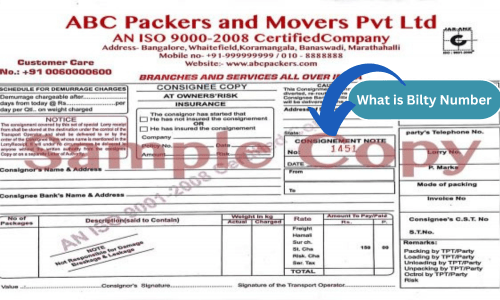What is Bilty Number: In the complex world of logistics and transportation, precision and organization are paramount. Among the many documents and tracking mechanisms employed in this field, the humble “Bilty Number” stands as a crucial identifier that ensures the smooth movement of goods from one place to another. In this blog post, we’ll take a deep dive into what a Bilty Number is, why it’s essential, and how it simplifies the logistics process.
Understanding Bilty Numbers:
A Bilty Number, often spelled as “Billty Number,” is a unique identification code assigned to a shipment or consignment of goods. It serves as a primary reference for tracking and managing goods during transit. This numeric or alphanumeric code is typically generated and provided by the transporter, freight forwarder, or logistics company responsible for handling the shipment.
Significance of Bilty Numbers:
- Tracking and Traceability: Bilty Numbers play a pivotal role in ensuring the traceability of goods. They allow shippers, consignees, and logistics providers to monitor the status and location of the cargo throughout its journey.
- Documentation: Bilty Numbers are an integral part of the documentation process. They are included in various transportation documents, such as the Lorry Receipt (LR) or the Goods Receipt (GR), adding an extra layer of accountability.
- Efficient Handling: With Bilty Numbers, goods can be quickly identified and matched with the relevant shipping documents. This reduces the risk of errors, delays, or misplacements in the logistics chain.
Generating Bilty Numbers:
The process of generating Bilty Numbers involves the logistics provider assigning a unique code to each shipment. This code is typically alphanumeric and may follow a specific format that aids in organizing and categorizing shipments. It includes details such as the consignor’s or consignee’s name, date of shipment, and a unique identifier.
How Bilty Numbers Simplify Logistics:
- Streamlined Communication: Bilty Numbers facilitate efficient communication between various stakeholders involved in the supply chain. Whether it’s the shipper, consignee, or transporter, everyone can easily refer to the Bilty Number to discuss or inquire about the shipment’s status.
- Inventory Management: For businesses, Bilty Numbers help in managing inventory. They enable companies to accurately record when goods are dispatched, received, or in transit, aiding in stock management and order fulfillment.
- Dispute Resolution: In cases of disputes or discrepancies, Bilty Numbers provide a solid basis for investigation. They help pinpoint the exact shipment in question and track its movement to resolve issues swiftly.
Related Post: What is the Difference Between Full Truckload and LTL?
In the intricate web of logistics, Bilty Numbers emerge as unsung heroes. These unassuming codes simplify the tracking, documentation, and management of goods during transit, ensuring that shipments reach their destinations smoothly and efficiently. Whether you’re a business owner, a logistics professional, or simply curious about the world of transportation, understanding the significance of Bilty Numbers is a crucial step in comprehending the logistics puzzle.
So, the next time you come across a Bilty Number on a shipping document, remember that it represents much more than just a sequence of characters; it’s the key to a well-organized, accountable, and streamlined logistics process.
What is Bilty?
Bilty” in transportation is a term often used in the Indian subcontinent, particularly in India and Pakistan, to refer to a key document associated with the shipment of goods. This document is more commonly known as a “Lorry Receipt” (LR) or “Goods Receipt” (GR) in other parts of the world. Let’s break down what “bilty” means and its significance in transportation:
Bilty Charges:
Bilty charges refer to the fees or costs associated with the issuance and handling of the bilty document. These charges cover administrative and documentation expenses related to the transportation of goods. Bilty charges may vary depending on the transportation company, the distance traveled, and the nature of the goods being shipped.
What is Bilty in Transportation:
In transportation, “Bilty” is a colloquial term often used to refer to the “Lorry Receipt” (LR) or “Goods Receipt” (GR). This document serves as proof that goods have been received by a transporter or carrier for transportation from one location to another. It includes essential information about the shipment, such as the consignor’s and consignee’s details, the description of the goods, the quantity, the destination, and, sometimes, the bilty number.
What is Bilty in Hindi:
The term “Bilty” in Hindi can be understood as “बिल्टी” and is commonly used in the context of logistics and transportation. It is used to refer to the Lorry Receipt (LR) or Goods Receipt (GR), as previously mentioned.
Significance of Bilty in Transport:
The Bilty, or Lorry Receipt (LR) or Goods Receipt (GR), plays a pivotal role in the transport and logistics industry. Its significance lies in the following aspects:
Receipt and Acknowledgment: It serves as proof that the transporter has taken possession of the goods and is responsible for their safe delivery.
Documentation: The Bilty contains essential information about the shipment, which is vital for record-keeping and documentation purposes.
Tracking: It facilitates the tracking and monitoring of goods during transit, helping both the shipper and the consignee stay informed about the status and location of their cargo.
Legal Value: In case of disputes, the Bilty can serve as legal evidence to resolve issues related to the shipment.
Accountability: The Bilty creates accountability, ensuring that the transporter is responsible for the safe and timely delivery of the goods to their destination.
In summary, while “bilty” may be a term used colloquially in the transportation industry in certain regions, it refers to the important document known as the Lorry Receipt (LR) or Goods Receipt (GR). This document is essential for the proper handling, documentation, and accountability of goods during their journey from the sender to the receiver.
